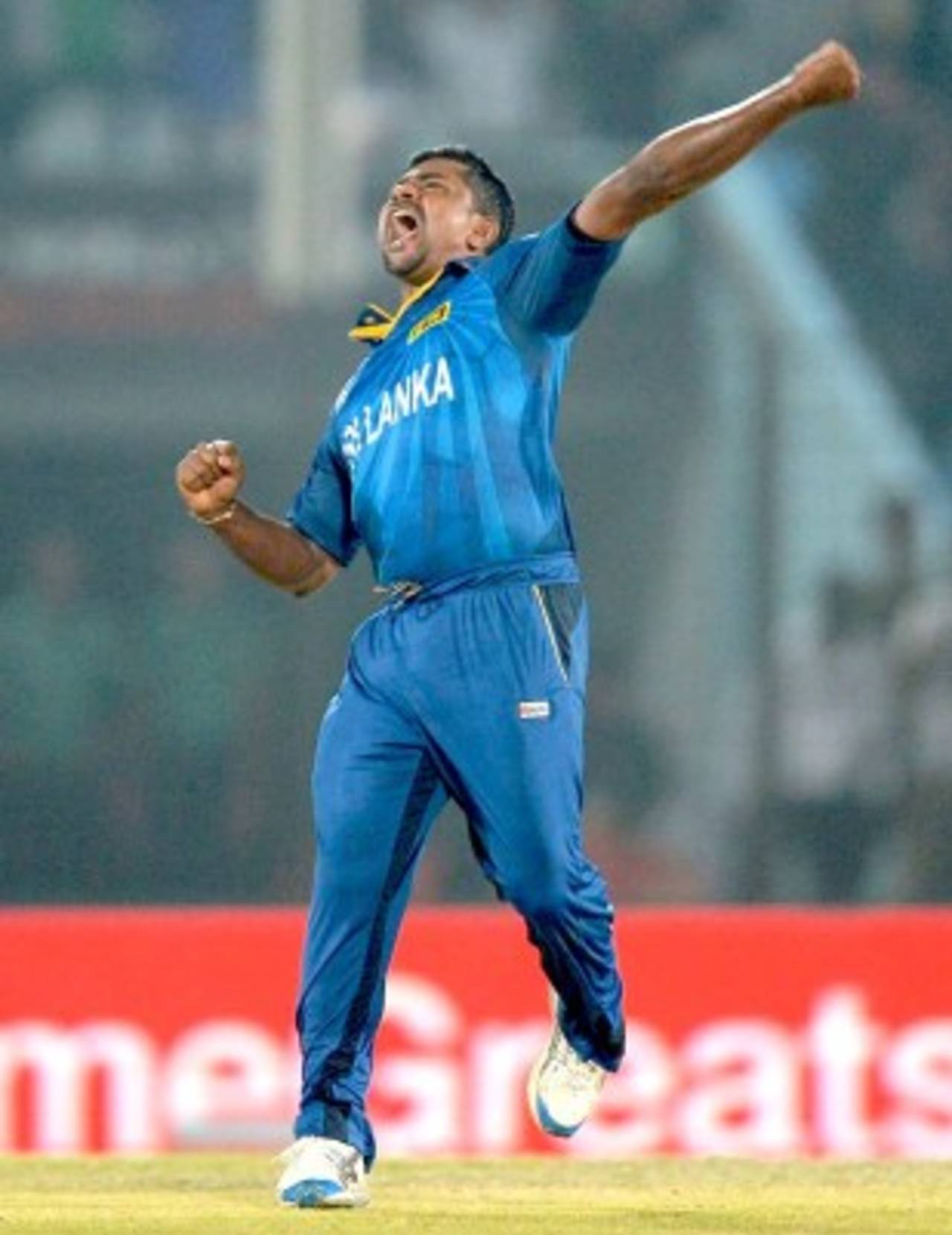Dhaka pitch a fresh challenge for SL, SA
Mirpur will provide more grip and turn for the spinners than the surface in Chittagong, which held together through most of the Super 10 stage. South Africa and Sri Lanka, therefore, will need to adapt quickly
Alan Gardner and Mohammad Isam
02-Apr-2014

Friendlier pitch awaits Rangana Herath in Dhaka • Getty Images
As South Africa and Sri Lanka tread back to Dhaka for the final stages of the World T20, a lot of the focus will be on how quickly these two teams adjust to the surface at the Shere Bangla National Stadium. They have been presented with a perceptibly different set of conditions in Chittagong, which were challenging in their own right but didn't resemble those in Dhaka all that closely.
Both sides will play evening matches, which means they may have to contend with a bit of dew, but they can only guess the extent. What they can be sure of is that the surface will be dry and will become drier as the three hours progress. The pitches in Mirpur have been kind to spinners, affording them the luxury of considerable turn and some bounce.
By contrast, the surface at the Zahur Ahmed Chowdhury Stadium was faster than expected, with little turn for the spinners. The brown clay differs from the soil used in Mirpur, where the clay constituent is black, and it keeps its character better throughout the day; during the evening, the behaviour of black clay can be quite changeable, as seen in how much the scores and results varied between the 3.30 pm and 7.30 pm starts.
In Chittagong, leaving on a layer of grass helped retain a little extra moisture and further protection from drying came from a hessian cover used during the main part of the day. There were up to seven pitches on the square, with two main ones rotated for the fixtures at ZACS. Dew was a problem in some of the evening games, and it was unclear whether use of an anti-dew spray had any effect.
Rain also whips in off the sea without much notice, in Chittagong. As summer arrives and temperatures rise - the extra heat and humidity are indicators of rain - brief storms, such as the one that curtailed the game between England and New Zealand, are fairly common. This also played some part in keeping the pitch fresh. The grass ensured the ball skidded on, generally aiding run-scoring.
From a local point of view, it was confusing to see how the Chittagong pitch behaved. It has traditionally been a bastion of batting, and is a favourite of many Bangladeshi batsmen looking for a quick fix in their form. The Bangladesh team have often stated privately, and publicly at times, that the Chittagong pitches make them feel more at home, particularly in Test cricket. Recently, they drew Tests against New Zealand and Sri Lanka there, and their comfort level was quite evident.
Sri Lanka and South Africa can still expect runs in Dhaka, though. There haven't been too many low-scoring games here, apart from Afghanistan getting blown away for 72 or Australia's 86 all out against India. There were ten 150-plus scores with Pakistan making 191 and 190 against Australia and Bangladesh. Five teams have won chasing in ten games, twice in the last over. But teams that have won batting first have mostly won by big margins - 16, 73, 50, 73 and 84 runs.
Three of the top five wicket-takers in Mirpur have been spinners - Amit Mishra, R Ashwin and Samuel Badree - and that was along expected lines. Umar Gul and Al-Amin Hossain were the seamers with most wickets, but that was more due to their variations and diligence than the pitch.
Teams batting second have made faster starts and hit more sixes (16 as opposed to 8) in powerplays than while batting first.
At the start of the Super 10 group stage, New Zealand captain Brendon McCullum perfectly summed up the difference between the two venues.
"In this set-up [Chittagong], I don't anticipate spin will play a great role from the point of seeing the ball turn and bounce past the bat," he said. "Good spinners still manage to play a vital role in T20 cricket but it just won't be quite the same role that we'll see up the road in Dhaka."
Only on the last day of competition at the Zahur Ahmed Chowdhury did the pitch begin slow and offer turn, as New Zealand finally lost out to the conditions. The absence of dew, possibly due to a spray used on the outfield, gave Sri Lanka the advantage, according to stand-in captain Lasith Malinga, and may have helped prepare them for the Dhaka leg of the competition.
"We were worried about the dew factor but fortunately for us there was no dew on that day and it worked to our advantage because the spinners managed to get a grip on the ball and take wickets," Malinga said.
When asked about the difference between the two venues, early in the tournament, Sri Lanka's regular captain Dinesh Chandimal had a succinct response. "We are looking forward to Dhaka."
Alan Gardner is an assistant editor at ESPNcricinfo. He tweets here
Mohammad Isam is ESPNcricinfo's Bangladesh correspondent. He tweets here